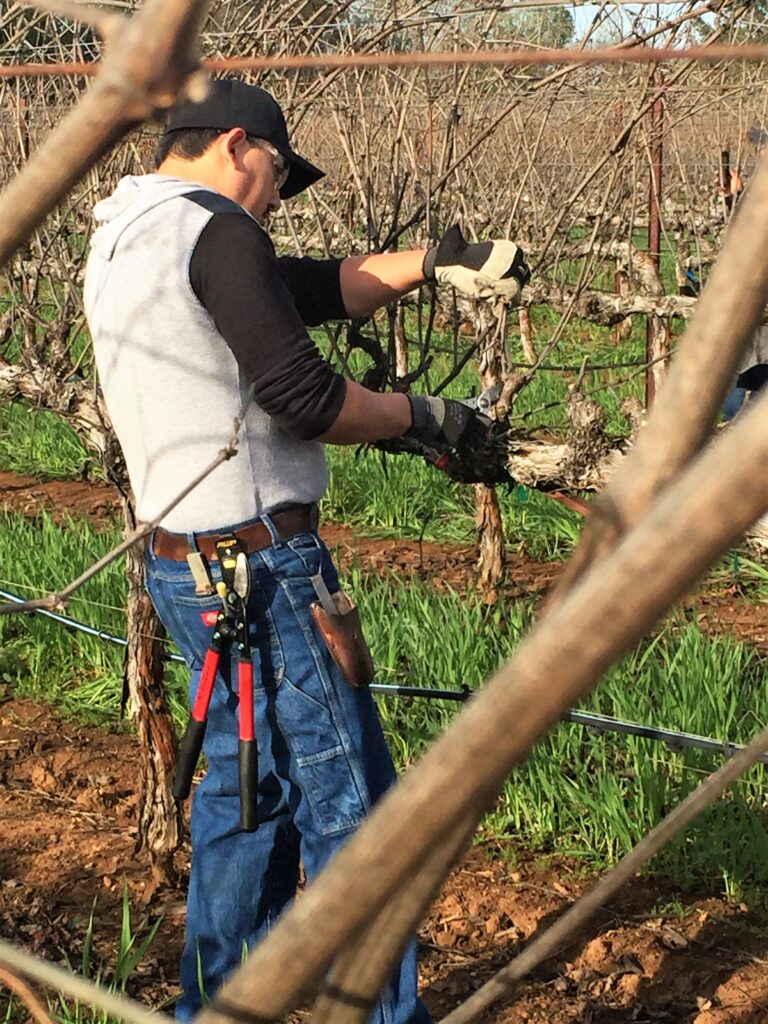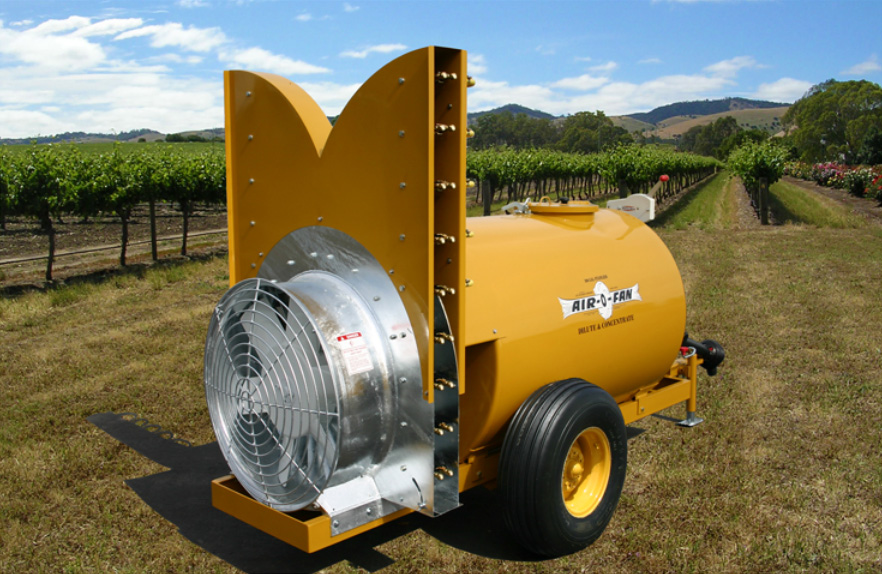Looking like a great year (for trunk disease)
Sorry to be a Negative Nancy...
The recent rain we’ve been getting is certainly a welcome change for us in California. Wet weather does, however, present other challenges especially going into the pruning season. That’s right. I’m talking about trunk disease. It’s everywhere, and like viruses, growers like to pretend they don’t have it. After all, it takes years before symptoms express themselves and even longer before they amount to an economic loss. But economic loss from trunk disease is real and, uh, expensive. No one likes being told their best option is tearing out and replanting a vineyard, so let’s go over some ways to be proactive. We’re all stuck in the office right now anyway.
What is trunk disease?
Trunk disease is a catch all term that refers to fungal diseases Eutypa, Botryosphaeria dieback, and to a lesser extent, Esca. I’ve written previously about Esca, which is not usually of immense concern in California. In the interest of simplicity, I am limiting the scope of this article to the former two. Both of these diseases blankets a laundry list of offending pathogens, the most common being Eutypa lata for Eutypa and Neofusicoccum parvum for Botryosphaeria.
These pathogens spread during wet weather. Ascospores are released by rain and disseminated by wind and rain splashes and move from infected vines or pruning residue and infiltrate healthy vines through fresh pruning wounds.
You can geek out on the Latin names if you want, but most growers are concerned with the symptoms and the damage they cause. Eutypa and Botryosphaeria cause occlusion of the vascular tissue of the vine and subsequent stunting of vegetation downstream of their colonies. Eventually it renders entire sections of the vine dead. If you want to narrow down the diagnosis, you can cut into the trunk. Eutypa leaves a pie-slice-shaped lesion of necrotic tissue in a cut trunk or cordon. Botryosphaeria does too, but is more aggressive, so the canker tends to take up a larger portion of the cross section. In either case, that vine will not return to full production unless it is drastically cut back and retrained from a trunk sucker. Even then, the fungus can still be present in asymptomatic tissue, so it’s important to cut the trunk back aggressively. Removing only cankered wood may not eradicate the disease. Then you’ve done all that work for nothing.

Why is controlling for trunk disease so important?
Trunk disease significantly reduces the longevity of your vineyard and further serves as an inoculum for infecting healthy blocks. While you can cut-back infected vines and try to start anew, it’s far better and cheaper and to prevent infection from the start.
There are several cultural methods you can use to prevent trunk disease. Removing infected vines and burning pruning residue is always recommended. You can hold off on pruning until dry weather. Alternatively, you can pre-prune spur-pruned vines during the wet season and finish up in the late-winter, when inoculum levels are lower and pruning cuts less susceptible to infection. Cane-pruned vines are less susceptible to trunk disease than spur-pruned vines, however converting from one to the other usually creates sizeable wounds that need to be protected. Cane-pruning may not be feasible for your business, especially if you rely on mechanical pruning. Likewise, you may not have the work force to wait for a favorable forecast before you start pruning. Like all things farming, you’ve got to do what works for you.
Available paint-on treatments
The most effective treatment method is to paint pruning wounds with a fungicide and/or sealant. B-Lock wound paint is a standard go-to and it is organic. It does however contain boron, which can be phytotoxic to the upper bud. It’s recommended to leave at least an inch of buffer wood if you’re painting with B-Lock. Otherwise, you can lose the terminal bud to boron-toxicity. B-Lock is essentially Boric acid in a latex paint and it can wash off if rainfall is persistent. It’s hard to beat the price though.
Vitiseal is another paint-on option. It isn’t fungicidal but it is a long-lasting polymer that stays put. Vitiseal doesn’t have any action against fungi, but it can be blended the fungicide Topsin-M (Thiophanate-methyl), making it more effective. While Vitiseal is organic, Topsin-M is not.

Paint? Or spray??
Painting every wound can be tedious and expensive. Spray-on treatments are a cheaper alternative, however care must be taken to adequately reach what amounts to a very small and specific target. Mundy et. al 2019, a study from New Zealand, compared different types of spray application to paint-on methods for several synthetic fungicides. The study examined an air-blast sprayer, a modified weed-sprayer, a tangential sprayer, and a recycle sprayer. In all cases, unnecessary nozzles were turned off in order to focus on the pruning-wound zone.
The study found that both tractor-sprayer and paint-on applications were comparable in their ability to defend against both Eutypa and Botryosphaeria (Their research focused on the pathogen Neofusicoccum luteum). This can be attributed to the excellent coverage they attained. According to measurements taken using water sensitive paper, coverage was between 74% in the case of the air-blast sprayer and 98% with the recycle sprayer. I noticed that the latter sprayer used upwards of 100 gallons/acre, which for such a small target is a lot of spray.
It’s also worth mentioning that the paint-on application in this study contained no surfactant or wound sealant that would make it stick to the wound. One of the only reasons you would opt to paint rather than spray is so that you could add it to something long-lasting like Vitiseal. Frankly, that they used no surfactant or wound protectant along with their sprays takes some of the wind out this study.
The point I’m trying to make is that you can get good coverage using modified spray techniques. That may or may not compare as favorably to painting. Given that hand-painting can cost double or triple what a pass with a sprayer will do, it may be good enough.

What about biologicals?
Commonly-used fungicides that are spray-applied are Rally (Myclobutanil) and Mettle (Tetraconazole (both FRAC 3). These two have shown some reduced effectiveness against powdery mildew due to resistance but are still very effective against trunk disease pathogens. Adding Topsin-M to the spray tank further increases its effectiveness, especially against Botryosphaeria. Adding one of these to the mix is not an option if you’re organic, however. So, what about biological fungicides that are organically-acceptable but effective?
There are many biological control agents on the market for defense against trunk disease. Scientists at UC Davis recently published findings comparing the effectiveness of several biologicals against classic chemical controls. Eskalen et al. 2021 conducted simultaneous greenhouse and field trials, comparing the effectiveness of various products in the case of single, double, and triple pathogen inoculations of Eutypa and Botryosphaeria (Eutypa lata and Neofusicoccum parvum respectively). The repeated pathogen challenges simulate how a fungicide application would fair during inclement weather that favored spreading the disease.
What they found was that Trichoderma species, notably a combination of Trichoderma asperellum plus T. gamsii, did extremely well in the greenhouse study, reaching 100% recovery after four weeks. In field trials, the results were variable, confirming previous studies that it’s action in the field depends on several factors such as variety, climate, and year. Trichoderma species still outperformed other biological treatments. It still couldn’t touch the reliability of good old Topsin and Rally one-two punch, but again, those two aren’t organic options.
If you are planning on giving biological control agents such as Trichoderma a shot, it’s important to realize that you are dealing with a living organism. In order for the treatment to be effective, you need to give it time to colonize the tissue. In the mentioned study, researchers waited seven days before inoculating with the pathogen as winter temperatures tend to slow the fungus’s natural rate of propagation. If you’re planning on treating with this method, you’ll need to be proactive about applying it on time, well ahead of the next rainfall event.
As far as method of application goes, this study sprayed treatments on with a squirt bottle. I would recommend combining Trichoderma with an adhesive paint such as Vitiseal. If you wanted to spray-apply it, I would recommend focusing your sprayer to the cordon or cane level to maximize the product’s contact with pruning wounds. Here’s where you can put that New Zealand study to good use. Biologicals aren’t the cheapest option out there. A backpack sprayer may be your best bet, especially if it continues to pour and you can’t get into the vineyard with a tractor.
Conclusion
This year is looking wet (let’s hope) and we may be forced to prune in weather that favors infection. Being proactive is the best way to prolong the life of your vineyard and avoid a premature replant.
Author’s note: This article is intended for discussion purposes only. They do not constitute a recommendation. For specifics on products and application rates, consult your PCA.
Citations
Blundell, R., & Eskalen, A. (2022). Evaluation of biological and chemical pruning wound protectants to control grapevine trunk disease pathogens Eutypa lata and Neofusicoccum parvum. Plant Health Progress, PHP-08.
Sosnowski, M. R., & Mundy, D. C. (2019). Pruning wound protection strategies for simultaneous control of Eutypa and Botryosphaeria dieback in New Zealand. Plant disease, 103(3), 519-525.

